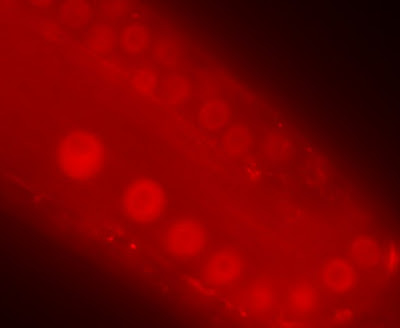Here is an idea of the sort of distribution information we can glean from eBird. The following 4 images are sightings of Magnolia Warbler, filtered by month for March to June of 2015. The purple boxes represent Magnolia Warbler sightings, with darker colors corresponding to increased frequency. We can literally see the birds moving north from their wintering grounds to their breeding grounds! How cool is that?!?! Bird migration in near real time! There are dozens of similar applications for an trends in the collected data. It is all archived and readily accessible and will be so in perpetuity (hopefully!)
March
April
May
June
Now, I will confess that I was a bit late to the eBird party; I only started eBirding in December of last year. Why did I wait so long to get on the eBird bandwagon? Much of it had to do with my career as a scientist where my entire professional existence revolved around counting various things: numbers of embryos, numbers of synapses etc. At that time, birding was my escape from data, and, as a result, I could not face additional data collection and entry on my personal time. Also, as I began to take a more-photography-centric view of birds, I didn't think my input would really prove that valuable since I wasn't really looking for birds beyond my photographic radius.
During my bicycle Big Year, I relied very heavily on eBird to help formulate bird finding strategies. One thing that became painfully clear to me was that I was taking infinitely more from the database than I was contributing to it. As my year started to wind down and birding settled down a bit, I decided that I should make a conscious effort to contribute. This was done as much out of feeling of obligation as anything else. I am a relatively competent observer, and I bird very frequently (or at least I did before I moved to LA!); I am exactly the sort of person who should be contributing to eBird.
Anyway, what I quickly discovered is that eBird is TONS of fun, so much so that I am now totally addicted to it. As someone who is obsessed with data, record keeping, and trends, it really cool to see not only the amount of data collected in eBird, but also how the site manages my personal data. I now have a list for everything (hemisphere, state, county, etc) - and they're all in one place! My data, beyond its obvious scientific utility, now functions as a personal birding history, a chronicle of what I saw when and where. I only wish eBird had been around from the instant I started birding. This is sadly not the case, and, as I cannot go back in time, I will make what efforts I can to ensure than my birding history moving forward is complete. It is fantastic that my data serves both a communal, scientific function and a personal, historical purpose.
"I didn't eBird Broad-billed Sandpiper from Jamaica Bay in 1998!"
As I am headed to Texas next week for the Rio Grande Valley Birding Festival, I have been using eBird to keep daily tabs on 2 particularly interesting species: Northern Jacana and Collared Plover, both of which would be life birds for me. It's really a lot of fun to log in and see if the birds are still being seen. Fingers crossed that both stay put!
Lastly, I also want to send a shout out to the eBird curators and reviewers. I am sure that this job is usually thankless, but without proper administration and quality-control the long-term utility of the data would certainly be compromised. I am sure its a lot of work, so thank you.
Lastly (again), please also check out iNaturalist. This is a similar crowd-sourced data collection platform that includes (beyond birds) insects, plants, fish, mammals, whatever. It is also a very valuable resource!
Ooooo Ooooo Ooooo. Before I finally go, here's an actual bird photo for you! I took this at Malibu Lagoon a few weeks back. Photography has been painfully slow recently, but I'm hoping to make it out for at least some shooting this weekend. Please stay tuned!
Spotted Sandpiper - Arctitus macularius
Canon 500mm f/4 IS on EOS 7D2
1/3200 at f/5.6, ISO 800
Manual mode, handheld





















